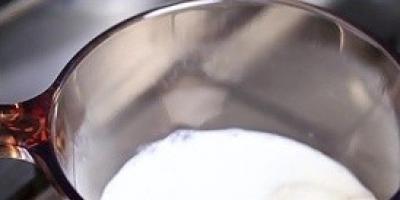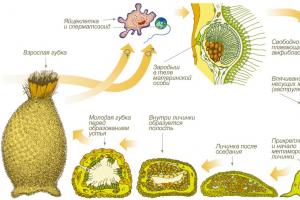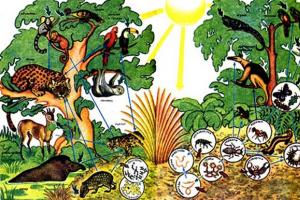Nightshade, or in other words - solanum, in the wild, grows in South America and belongs to a very large species group of nightshades, which has about one and a half thousand varieties.
Nightshade is a small tree or herbaceous bush with an evergreen crown covered with oval dark green foliage. This plant has gained wide popularity among lovers of home plants due to its special decorative properties. In addition to the beautiful bright leaves, the nightshade crown is dotted with white flowers and berries, which, as they develop, turn from lush green to red, and then to orange shades.
The fruits of some varieties of nightshade are very reminiscent of cherry berries, but you should never eat them - they are quite poisonous. All other parts of the solanum are also toxic, so nightshade lovers who have small children should think carefully before growing this plant at home.
Indoor nightshade is a plant that will not cause serious difficulties in care, even for novice gardeners. The rules are quite feasible and simple, the only thing worth paying attention to is Special attention, so this is the need to provide the plant with a cool winter. Below, about all this in detail.
Content temperature
During the warmer months of the year, the nightshade flower is quite happy with the temperature environment, familiar to our latitudes, but 18 - 28 ° C is still considered optimal, since it does not like extreme heat. Moreover, it is advisable to ensure natural daily temperature changes - at night he likes coolness.

But the solyanum is used to surviving winter at relatively low temperatures - 12 - 16 ° C, no more, otherwise it will shed its leaves and berries. In addition, if this condition is not met, the plant, which should rest in winter, will actively spend its energy on young shoots and by spring will be greatly depleted, which will affect its decorativeness and even health. In addition to the fact that such a bush is unlikely to bloom, it will often get sick.
Lighting
Decorative nightshade, like its natural relative, Solanum vulgare, loves a lot of light, so it is advisable to place it close to the window, and in the warm season, take it out to the balcony, terrace or garden. The plant feels best on a southwestern or southeastern windowsill, but if it is placed on the south side, on bright sunny days it needs to be shaded a little, otherwise there is a risk of foliage burns.

A lack of light is unacceptable - the nightshade stretches strongly upward, its stems become bare, the crown becomes sparse and overall development becomes inferior. In addition, the flowering of such nightshade is significantly worsened, and may not occur at all. Therefore, if it is not possible to provide him with enough natural light, you should take care of artificial light. The best option– purchase a special lamp for vegetation at a garden store that emits a spectrum close to that of the sun.
Watering and ambient humidity
Nightshade loves moisture, so it requires abundant and regular watering, but at the same time, like most plants, it does not tolerate stagnation of moisture. Therefore, it is worth taking care of reliable drainage - the flowerpot needs holes to drain water, and the soil must be loose, capable of easily allowing water to pass through. excess moisture. And of course, you should make sure that there is no water in the tray with the nightshade flowerpot.
Watering schedule: immediately after the top layer of soil dries, daily. This regime is maintained from mid-March until the end of summer, after which the intensity of watering must be reduced. Starting from October, it is reduced to minimal moisture, and the flower itself is transferred to a cool but well-lit place - the plant must rest until February inclusive.

As for air humidity, it is desirable that it be high, ideally 65% or higher. If the air is dry, you need to spray the crown daily or place a flowerpot with solyanum in a wide tray filled with wet expanded clay. By evaporating, it will provide the flower with a comfortable atmosphere. At the same time, it is impossible to overfill the tray - the roots of the plant should not be in water, and when spraying, it is better to cover the soil so as not to over-moisten it.
How and what to feed
Despite the unpretentiousness of decorative nightshade, in order for the plant to maximize its potential and grow healthy, it must be fed regularly - at least once a week in warm weather, and once a month late autumn and in winter.

For regular fertilization, it is better to use ready-made nutritional complexes for nightshade crops, and in mid-spring, when the plant is maximally active, it is worth feeding it with fertilizers for indoor flowers - this will speed up flowering. As a rule, solyanum is fertilized with liquid compounds by watering the soil in which it grows. At the same time, it is worth controlling the concentration of the solution - it is very saturated, it can burn the root system. The same thing will happen when fertilizing dry soil - it needs to be watered before applying fertilizer.
This feeding will ensure regular, abundant flowering and a large number of fruits
Transfer
Nightshade requires regular pruning and replanting. It's better to do it in early spring, when the red fruits covering the crown are completely ripe and begin to fall off. The flowerpot is selected depending on the size of the root system and filled with a feeding substrate, having previously poured a drainage layer of pebbles or expanded clay onto the bottom. The substrate can be bought ready-made or made independently, based on humus, sand and high turf soil. Be sure to clear the ground of weeds and other vegetation before preparing the soil.

Before transplanting, the nightshade bush needs to be cut by about half and then transplanted into a new flowerpot. After this, for some time, until the plant acclimatizes, you need to care for it especially carefully. The main thing is that there is optimal mode watering and enough light.
In addition to annual replanting, in warm weather it is necessary to pinch the tops and very elongated branches - this will make the bush more lush and ensure dense flowering.
Reproduction
Nightshade is a common solanum, capable of propagation by seeds and vegetatively by cuttings. Both of these methods are suitable for growing plants in room conditions.
Seeds sown in March germinate best. They are sown without being buried in nurseries and germinated in greenhouse conditions, with plastic film stretched over the top. In this case, you need to maintain a temperature of approximately 22 - 24°C. Be sure to monitor humidity and provide sufficient lighting. In the third week, the first shoots will appear, and by the time the seedlings have 3–4 leaves, the seedlings need to be plucked. For this you can use plastic cups, with a drainage hole punched at the bottom. As they grow, the seedlings need to be pinched to branch the crown, and when they become stronger, they can be transplanted into flowerpots to permanent place growth.
Cuttings can be carried out in early spring and summer. The cuttings that take root best are those taken from the upper sections of the nightshade stem, cut at the bottom, slightly above the bud, always at an angle of 45°, and it is desirable that they have 3–4 leaves. They are planted, each separately, in peat soil or special peat tablet and root, covering with transparent glass jar. When the cuttings take root, they can be transplanted into flowerpots and, at first, regular pinching can be done to form a dense crown.
At proper care, pretty soon, the cutting turns into a developed plant, covered with flowers and beautiful red fruits.
(Solanum) is a shrub from the nightshade family, the genus of which has about 1,700 species. South American countries with a tropical climate are considered the homeland of nightshade. In the wild you can find annual and perennial herbaceous plants in the form of shrubs and trees, the stems of which can creep or stand upright, and the fruits are predominantly poisonous. Among the nightshades there are edible species, such as potatoes, tomatoes and eggplants.
A small number of nightshade representatives are suitable for cultivation at home - the most common are edged, pepper and dark brown nightshades, the fruits of which are compared to small tomatoes, cherries or Mexican peppers. These Latin American machos are able to please their owners decorative look all year round. However, to do this you need to know some tricks of caring for this plant.
Indoor nightshade is popularly called winter cherry or coral bush. Quite often in home cultivation you can find pepper and false pepper nightshades. They differ from each other, although only slightly. The main difference lies in the shoots of the bush. False pepper nightshade has smooth, hairless shoots and leaves, while pepper nightshade has them covered with a light gray fluff. They also differ in their properties.
The fruits of pepper nightshade are used in folk medicine for the treatment of sore throats and wound healing, and the false pepper representative is a poisonous killer.
Therefore, if a plant decorates the interior of a room, it should be located at a considerable distance from the floor so that children’s little hands do not get to the delicious berries.
Nightshade reaches a height of half a meter, is very decorative and often becomes a decoration during the New Year holidays, when the fluffy green bush is strewn with bright multi-colored berries, hence the name - winter cherry. Small berries appear after flowering and as they ripen they change color from green to rich burgundy. At the same time, the ripening of fruits on one bush is uneven, so cherries, tomatoes or peppers are of different shades, which increases the decorativeness of the plant.

It should be remembered that decorative nightshade is a plant from the tropics, so the conditions should be as close to natural as possible. The plant requires constant spraying and maintaining an optimal temperature, which is lowered in the winter.
The flower is also quite light-loving, but categorically cannot tolerate direct sunlight.
If a flower doesn’t like something, it will notify you about it:
- dropping leaves means the plant lacks light
- scant flowering and small fruits - about insufficient heat
- curling leaves - about excess sun rays
- drooping, limp leaves - about poor watering and a hot place
- shrinking berries - about a lack of moisture in the soil
- dull leaves - about lack of nutrition
The humidity level should always be high and not fall below 60%.

Reproduction indoor plant can be done with seeds and:
- When planting seeds, leaf soil is most suitable, on the surface of which the seed is laid out at a distance of 2 cm from each other and sprinkled with sand. The container is placed in a warm place for germination, creating greenhouse conditions using a film cover. Within 10 days, the seeds will sprout. In the first stages, the borings grow very intensively and therefore they are needed, and this procedure is carried out twice. This is necessary to give the future bush a compact spherical shape. After the second picking, the plant can be planted in the ground.
- The process of propagation using cuttings is a faster process. Cut branches are used as cuttings. It is easiest to root cuttings in a sand-peat mixture, and when a sufficient number of roots have formed, transplant the plant into suitable soil. With proper care, flowering and fruiting are possible in young flowers.
The method of propagation affects the development of nightshade and the size of its berries. When propagated by seeds, the plant grows longer, but is stronger and actively bears fruit. When cuttings, nightshade requires time to adapt and the fruits of the first are small and the flowering is sparse.
The optimal soil for nightshade is a mixture of peat and clay soil in a ratio of 1:3 with the addition of a small amount of sand. It is necessary to place expanded clay or crushed stone drainage at the bottom of the planting container; small brick fragments are also suitable.

Conditional care for decorative nightshade can be divided into three stages:
- Spring is the stage of planting and replanting a plant.
- Summer is the period of growing season and flowering.
- Autumn-winter is the time of fruiting and subsequent dormancy.
The basic principles of care are to provide the necessary conditions:
- Lighting. Achieving a brightly decorative flower is possible only by providing bright but diffused light, which the plant needs throughout the year. The eastern and western sides of the room are well suited for this. The south side will be very useful in winter. If there is not enough light, then the development of nightshade will be weak, and flowering and fruiting will be poor.
- Humidity and temperature regime. Optimal temperature indoors, for the full development of the plant, it is considered 18-25 degrees in spring and summer, and in winter it should be reduced to 12-15 degrees. Otherwise, your tropical friend will drop all the berries and leaves. You should also worry about protecting the nightshade from drafts. Humidity should always be high. To ensure this condition, the flower is systematically sprayed. It would be a good idea to place the pot with the plant in a shallow bowl with moistened rocky material so that there is no contact with water. With increased dry air, fruiting occurs later and is weaker.
- . In the spring and summer, when the plant is intensively developing and blooming, it should be watered frequently and abundantly. Irrigation is carried out immediately after the top layer of soil dries, which occurs quickly, since the nightshade sweats intensely, evaporating moisture through the foliage. IN winter time Watering should be reduced.
- . To bear fruit, nightshade requires a lot of strength, which can be provided by feeding. You can use complex liquid fertilizer for house flowers that bloom. It should be applied during the growing season and during fruit formation. Fertilizing is carried out once every two weeks, and when the fruits have already set, that is, in winter, the interval between fertilizing should be reduced to once a month, using half the fertilizer rate.
- . Nightshade pruning is carried out annually. At the end of winter or early spring, all branches of the bush are shortened by a third. This procedure is usually performed after the fruits have fully ripened and when the leaves turn yellow. In the fall, it is recommended to pinch the plant, but only those shoots where there are no buds or fruit ovaries. This will provide better bushiness.
- . After trimming ornamental shrub need to be replanted in renewed soil saturated with microelements. In this case, the pot should be slightly larger than before. But in some cases, replanting may not be necessary, because the nightshade flower quickly loses its decorative effect and it is often easier to grow a new plant.

Although nightshade is an unpretentious plant, some difficulties in its maintenance still exist:
- Poor fruiting or lack thereof. This is caused by insufficient pollination during the flowering period. If the plant is not carried to open air, then it is recommended to pollinate it artificially. For these purposes, use a soft brush, with which pollen should be transferred from one flower to another. To consolidate the effect, the procedure is carried out several times.
- Nightshade sheds leaves and berries. The cause may be drafts, sudden temperature changes or heat. To eliminate these troubles, you just need to find a more suitable place for nightshade.
- Pests. Insects can also cause inconvenience to the plant: whiteflies and spider mites. Those plants that are kept in dry air conditions are at risk. When you detect the first signs of an insect attack, you should treat the plant with appropriate chemicals or use folk remedies (if the damage is not severe).

Some varieties of nightshade are poisonous. Even a small concentration toxic substances contained in fruits can lead to poisoning. This usually results in stomach upset, but at high concentrations it can cause toxicity throughout the body, which may require medical intervention.
Along with this, nightshade also has medicinal properties and can act as a home healer. The fruits and leaves of the plant are used for the prevention and treatment of many diseases, because they contain vitamins, carotenoids, alkaloids, pectins and saponin acids. These substances effectively fight bronchitis, sore throat and whooping cough, and are also capable of healing wounds well. In addition, infusions prepared from nightshade have anthelmintic and diuretic effects.
However, due to the toxicity of the plant, nightshade medicines should be used very carefully, after consulting with a specialist.
Flower Nightshade is quite easy to grow at home. An unpretentious and ornamental plant will require a little effort and compliance with simple rules. And due to its decorative effect, nightshade is able to decorate and diversify any interior and give a festive mood. The flower will gratefully respond to care with flowering and fruiting, giving the plant originality. And the flower can also cure household inhabitants from unpleasant diseases. However, you should keep the plant away from children to avoid unpleasant consequences.
More information can be found in the video:
Many people strive to grow not simple flowers at home, but interesting and unusual plants. Those interested in a decorative window sill dweller should be interested in the nightshade. This plant has an unusual appearance, which is decorated with berries, giving the bush an elegant look. In order for a crop to grow and bear fruit correctly, it is important to know how to grow it correctly.

Description of the plant
Nightshade is a plant that belongs to the genus Solanaceae and has more than a thousand varieties. It spread from Ecuador, Peru and the island of Madeira. A large amount of this culture can be observed in South America. Nightshade can grow in almost any climate, but prefers regions with warm climates. In Australia, the amount of nightshade has become so large that it has been classified as a weed and is being actively controlled, which is not so easy.
In nature, the plant usually grows up to one meter, at home it slightly exceeds half a meter, but the most common option has become the dwarf nightshade, which is considered a flower and is grown in apartments. Its parameters do not exceed thirty centimeters, but otherwise it is not much different from the wild variety. A special feature is the foliage, which remains green all year round, its color is dark green and its edges have a wavy shape.


Nightshade blooms with white flowers, which can be collected in small inflorescences or grow singly. The flowering period can occur in any season, and the berries usually appear and turn red in winter. The fruits range in size from one to one and a half centimeters and color scheme from red to deep orange. If we talk about decorativeness of this flower, then it consists precisely in the combination of dark leaves and bright fruit beads that stay on the branches for a long time without fading or falling off. Those interested in growing nightshade should know its main varieties.
- Pepper-shaped– grows about half a meter in height, has green foliage, the flowering process is carried out by pale white flowers from which appear poisonous berries, changing color from yellow to deep red.


- False pepper– the main indicators are similar to the previous version, only the height of the plant differs, which can reach one and a half meters. The variety blooms all year round, alternately producing fruits that ripen over time. The dwarf variety, which is grown at home, usually has a height of no more than 30 centimeters.


- Jasmine- characterized by a climbing stem and complex oval-shaped leaves; flowering occurs with white flowers with a blue tint, which are collected in paniculate inflorescences.

- Curly- has a climbing stem that can reach five meters in height with oval dark leaves and purple flowers that are collected in inflorescences.

- Variety "Rantonetti"– is a dwarf tree with small blue flowers.

- Papillary- named after the owl original form fruits that have an elongated appearance. The bush reaches one meter, has leaves of a soft structure that are somewhat similar to burdock, and the stems are dotted with thorns. Flowering occurs with white or purple flowers, and the fruits are colored red or orange.

Indoor nightshade will be a window decoration, especially in winter, when the bush is completely covered with berries that look like New Year's lights. Since there are a large number of varieties, the type of fruit and flower may have different dimensions, color and shape, but the differences are not too significant, so it will be possible to determine whether it belongs to the Solanaceae genus without any problems.
wild and decorative options They usually differ in the size of the plant; if in nature nightshade is a real tree, then indoors it looks more like an ordinary flower. Since in some regions this shrub is a weed, it is important to propagate this crop correctly. False pepper and pepper nightshade are the most popular varieties of the plant, which is why they can most often be seen both on sale and in people’s homes.
These varieties differ in many ways. Different dimensions, different inflorescences, but almost identical fruits. The three-flowered nightshade is especially valuable in decorative design, since it produces a whole bunch of beautiful, uniform berries that serve as a wonderful decoration landscape design or premises.

To grow nightshade at home, it is important to know exactly how to plant and grow it, as well as become familiar with the crop, which poses a certain danger, especially if there are small children in the house.
Is it possible to eat it?
Nightshade cannot be eaten as food, this is due to the fact that all its parts are dangerous to human health. It is especially poisonous when ripe fruits appear, which often attract small children and pets. Eating several berries will lead to significant disruptions in the functioning of the stomach, but excessive consumption of fruits can result in death.
There are some varieties that can be eaten, but you should not do this without properly preparing the fruits. This plant is very effective in combating various diseases, such as tonsillitis, migraine, epilepsy. To get the most out of nightshade, you need to collect ripe berries, flowers and leaves from it, dry them in an open space and store them in a dry room, wrapped in paper. Possible options uses can be:
- twisting through a meat grinder and mixing with sugar or honey, which effectively helps against severe headaches and relieves attacks of epilepsy;
- Healing decoctions are obtained from flowers that help improve patients with pulmonary diseases;
- dried leaves that are collected and dried between July and September can also help with various diseases.
If there is a need to enhance the effects of nightshade, it should be used with a number of other herbs that combine with it. Without the proper knowledge, you should refrain from consuming any parts of the plant and not growing it at all if there are children or pets living in the room.
Growing and care at home
Growing indoor nightshade is not difficult, because it feels comfortable on almost any soil; the main condition is only a warm habitat to which the plant is accustomed. Since the culture is decorative and takes up little space, it is usually grown in a pot and placed on the windowsill. To get good growth and bright fruit, it is important to create optimal conditions, which consist of suitable soil. For planting to be successful, you need to prepare alkaline, loamy or clayey soils, the main thing is that they are quite loose.

It is not difficult to care for the plant; you need to water it on time and provide it with enough light, but do not place it in direct sunlight. At the end of spring and summer, you can place the bush on the balcony or veranda, where there will be access to clean air And good lighting. Another feature that gardeners can learn about is the need to transplant the bush after a year into a new, larger pot. If you plant nightshade in a container smaller than the one that is suitable for it, then the root system will have nowhere to develop, and the crop will begin to wither.
Watering nightshade differs in intensity depending on the time of year and the ambient temperature; in cool weather, just a little water is added, and in extreme heat, quite a lot, plus additional spraying of the foliage, which the bush perceives very favorably.
The most important thing is flowering and fruiting, so at this time you should be especially careful about introducing moisture under the bush so that the soil does not dry out. A relative problem in care is the flowering period, which often simply cannot be achieved due to ignorance of certain secrets.

In order for the plant to lose color in the spring, you need to place it in a cool room in the winter and reduce watering. A properly overwintered bush can be pruned and shaped as desired, giving it a wide variety of shapes. Another feature is the fear of drafts, so for the time of ventilation you need to put the nightshade in a quiet and cozy place.
The temperature regime is no less important; if in summer there is no need to create any specific conditions, then in winter it is worth placing the bush in a room where the temperature will be no more than fifteen degrees Celsius. The window on which the nightshade will be located should also be changed from time to time; in the cool season, the south side is ideal, where there will be the most light, and in the summer, on the contrary, it is worth placing the bush on the opposite side.
For good growth crops need to be fertilized from time to time. The fertilizing period occurs in spring and summer, when useful material applied to the soil twice a month. Nightshade is best suited complex fertilizers, as for any flowering plants. It is not recommended to fertilize the soil in winter, but if such a need arises, the procedure is carried out no more than once a month. And then it is enough to add only half the amount that is usually used.


Caring for the plant also involves pruning, which is carried out when the bush completely stops bearing fruit. With the approach of spring, you can see the yellowing leaves of nightshade falling off. To stop this process, it is worth using pruning, which helps restore the strength of the plant. A feature of pruning is the shortening of the main stem, which makes it possible for the peripheral shoots to actively grow, on which it is recommended to pinch the tips.
Those who want to grow this plant at home should know that cultivation is possible from seeds, which are obtained thanks to the fruits, which are stored throughout the active growing season, as well as throughout the winter. To get them, you need to collect only ripe fruits, dry them and store them dry until spring.
To know that nightshade is ripe, you just need to pay attention to the color of the berries, which turn from green to yellow and, when ripe, acquire a full red color.


Features of culture propagation
Nightshade is propagated in two ways: cuttings and seeds. With the help of seeds, a crop can sow itself, but this requires rather large dimensions of the pot in which it grows. It is advisable to transplant those sprouts that appear on their own from an adult bush when they get a little stronger. You can sow yourself, for which you select a container of considerable size in which the seeds are placed. There is no need to dip them into the ground; just dust the surface with a thin layer of sand.
To mortgage planting material sprouted, you need to cover it with film and place it in comfortable conditions. The most favorable temperature for this stage will be 20-22 degrees. The planting is periodically ventilated and watered. It is important not to allow water to stagnate or the soil to dry out too much.
If we are talking about the spring-summer period, then more convenient option cuttings will be used to propagate nightshade. In order for the planting material to take root well, it is important to place it in soil consisting of sand and peat mixed in equal proportions. In this case, it is also worth using film and covering the cutting. It will be possible to get rid of it when more than four leaves appear and the plant goes into active growth. Those who want to have a nightshade with a large number of branches should prune the bush quite often, which will become an impetus for the increased growth of new branches.
In order for the cutting to take root faster in the new soil, after cutting it from the main bush, it is additionally treated with “Kornevin”, which stimulates faster growth of the root system. For propagation, it is worth choosing strong and developed branches that can produce the same new plants.
About indoor nightshade, tips for caring for it at home, see the following video.
Decorative nightshade flower and its care
Nightshade is ornamental plant, which has small red-orange berries. The flower is grown indoors, although previously it could only be seen in the wild.
Description of nightshade
Source: Depositphotos
Nightshade is a poisonous plant
Hybrid dwarf forms, which are classified as evergreens, are grown in a pot.
- False pepper nightshade bush no more than 40 cm in height.
- Pepper grows up to 1 meter.
- Jasmine falls like a vine.
The plant can bloom blue, white and purple. The fruits decorate the room with their bright red, orange or yellow tint. Their diameter does not exceed 2 cm. The nightshade flower bears fruit for 3 - 5 months. This period falls during the Christmas holidays, which is why people also call it Christmas cherry.
Nightshade care
Nightshade, like all indoor flowers, needs quality care. When growing nightshade, you should pay attention to:
- lighting;
- temperature;
- watering;
- air condition;
- pruning;
- soil and its fertilizing.
Decorative nightshade loves light, but there is no need to expose it to the sun in extreme heat. In the summer, you can take it outside to a place protected from direct sunlight and drafts. The optimal temperature for it is 20–25 °C in the spring-summer period and 12–17 °C in the autumn-winter period.
You need to water regularly from March to September. Also, to maintain humidity, spray or use water in a tray in the morning and evening. From autumn until the end of winter, solanum does not need watering. The bush is transferred to a cool place, and only spraying is done. Humidity should be at least 60%. This is necessary for its long fruiting and active growth.
Before planting, pay attention to the composition of the soil. A turf mixture, leaf humus and peat are best suited. When nightshade blooms and actively grows, it needs to be fertilized. This should be done once every 14–20 days. Fertilizers are suitable both as complex fertilizers for indoor flowers and as those used to fertilize tomatoes. Every year you need to cut off a third of the branches, especially those that have begun to dry out.
Photos of nightshade seen in flower shops, will help you decide on the subspecies of the plant. Any of them should be grown responsibly, adhering to all agrotechnical rules.
An amazing plant with which you can create an exotic green corner is indoor nightshade. Its main decoration is the fruits. They give the bush a chic and elegant look. The appearance of berries among the rich greenery resembles a spruce tree decorated with bright balls. Why not give yourself such a cute flower and admire its beauty? Let's take a closer look at the exquisite berry mosaic on the window.
Indoor nightshade: the secret of the plant's attractiveness
 In its natural environment, nightshade is most often found in regions with warm climates. Its homeland is South America, where it reaches a meter in height. In some countries, such as Australia, the plant is destroyed because it is considered a weed. Despite this, indoor nightshade attracts lovers of house plants.
In its natural environment, nightshade is most often found in regions with warm climates. Its homeland is South America, where it reaches a meter in height. In some countries, such as Australia, the plant is destroyed because it is considered a weed. Despite this, indoor nightshade attracts lovers of house plants.
 The flower grows to about 30 cm. From the outside it resembles a small bush. The oblong, lanceolate-shaped foliage has a rich dark green color, against which clearly defined veins are visible. The edges of the plates have a wavy frame, which gives the bush a spectacular look.
The flower grows to about 30 cm. From the outside it resembles a small bush. The oblong, lanceolate-shaped foliage has a rich dark green color, against which clearly defined veins are visible. The edges of the plates have a wavy frame, which gives the bush a spectacular look.
 During the flowering period, buds appear on the branches of indoor nightshade. They can grow in inflorescences of several pieces or singly. Interestingly, flowering occurs in different time warm season, but the berries appear in winter. Their dimensions are approximately 1.5 cm. The color when ripe can be from bright red to orange. From the outside it looks very beautiful. Against the background of dark green leaves, scarlet beads shine with bright lights, which remain on the shoots for several months. They do not wither or fall off.
During the flowering period, buds appear on the branches of indoor nightshade. They can grow in inflorescences of several pieces or singly. Interestingly, flowering occurs in different time warm season, but the berries appear in winter. Their dimensions are approximately 1.5 cm. The color when ripe can be from bright red to orange. From the outside it looks very beautiful. Against the background of dark green leaves, scarlet beads shine with bright lights, which remain on the shoots for several months. They do not wither or fall off.
Among the popular plant varieties, the indoor decorative nightshade “Three-flowered” is especially valued. During the fruiting period, clusters of homogeneous berries appear on the branches, which decorate the living space.
Simple rules for growing berry mosaics at home
 It is not difficult to grow a crop on your windowsill. It thrives in a variety of soils. The main condition is that the soil must be loose. Often, fans of home crops grow indoor nightshade from seeds, carefully observing its development. The process begins in late May or early June.
It is not difficult to grow a crop on your windowsill. It thrives in a variety of soils. The main condition is that the soil must be loose. Often, fans of home crops grow indoor nightshade from seeds, carefully observing its development. The process begins in late May or early June.
 In small containers filled suitable soil, spread the seeds evenly. Then they are covered with a layer of sand about 1 cm and irrigated with a spray bottle. Containers are covered plastic film and placed in a room where the temperature is not lower than 22°C. It should also have plenty of daylight. The first shoots will turn green on the surface of the earth in about 14 days. When they get stronger and there are 3 leaves on the shoots, the sprouts dive into other containers.
In small containers filled suitable soil, spread the seeds evenly. Then they are covered with a layer of sand about 1 cm and irrigated with a spray bottle. Containers are covered plastic film and placed in a room where the temperature is not lower than 22°C. It should also have plenty of daylight. The first shoots will turn green on the surface of the earth in about 14 days. When they get stronger and there are 3 leaves on the shoots, the sprouts dive into other containers.  After 30 days, the grown seedlings are transplanted again, but to a permanent habitat.
After 30 days, the grown seedlings are transplanted again, but to a permanent habitat.
The last dive is carried out when the nightshade bushes grow to 15 cm in height.
When the plant takes root, you need to know the rules of how to prune nightshade and not harm it. The procedure is performed several times a year. At the end of February or beginning of March, all shoots of the crop are shortened by a third of the main length. It is best to do this when all the berries are ripening and when the foliage turns yellow.
To effectively form an indoor nightshade bush, additional pruning is carried out in April or early May. The procedure is repeated before the buds open. To increase the bushiness of the crop in the fall, new shoots are pinched to branches where there are no buds and fruit ovaries. As a result, a cute one will appear on the windowsill decorative decoration strewn with bright fruits.
A smart approach to caring for indoor nightshade
 Since the plant came to Europe from tropical countries, its maintenance conditions must correspond to its natural habitat. A reasonable approach to caring for indoor nightshade at home leads to remarkable results. Exotic berries will become an exquisite decoration for your living space, turning it into an oasis of peace and pleasure.
Since the plant came to Europe from tropical countries, its maintenance conditions must correspond to its natural habitat. A reasonable approach to caring for indoor nightshade at home leads to remarkable results. Exotic berries will become an exquisite decoration for your living space, turning it into an oasis of peace and pleasure.
The basic rules of care are to create suitable conditions for the culture, which include:
- lighting;
- humidity;
- temperature regime;
- watering;
- fertilizing
Let's look at each procedure in detail to grow an exotic flower at home.
Sufficient light
 Practice shows that the correct one directly affects the decorativeness of nightshade. Throughout the season, the plant needs diffused light. Therefore, it is placed on windows facing east or west. When winter comes, the flower feels wonderful on the south side. With insufficient light, nightshade develops poorly and bears a small amount of fruit.
Practice shows that the correct one directly affects the decorativeness of nightshade. Throughout the season, the plant needs diffused light. Therefore, it is placed on windows facing east or west. When winter comes, the flower feels wonderful on the south side. With insufficient light, nightshade develops poorly and bears a small amount of fruit.
Reasonable temperature and humidity control
 For successful development tropical plant It is necessary to maintain an optimal temperature in the room. In spring and summer it ranges from 18 to 25°C, and in winter it reaches 12 or 15°C. If the temperature regime is violated, the flower will lose all its berries and foliage. This is one of the reasons why nightshade leaves fall at the most inopportune moment.
For successful development tropical plant It is necessary to maintain an optimal temperature in the room. In spring and summer it ranges from 18 to 25°C, and in winter it reaches 12 or 15°C. If the temperature regime is violated, the flower will lose all its berries and foliage. This is one of the reasons why nightshade leaves fall at the most inopportune moment.
The plant does not like drafts, so when ventilating the room, it is better to remove the pots with the crop to another place.
Since nightshade is native to the tropics, it needs regular spraying. Also, the flowerpot with the crop can be placed in a shallow tray with moistened drainage material. The main thing is that there is no direct contact with water. Insufficient air humidity has a detrimental effect on crop development. Therefore, gradually losing vitality, the nightshade dries out and may eventually die.
A wise approach to watering
 During intensive development, in spring and summer, the plant especially needs moisture. As soon as upper layer the soil dries out, and this happens quite quickly, it needs to be watered immediately. With the onset of autumn, and then winter, the amount of watering is reduced. As a result, the bush will always decorate the living space.
During intensive development, in spring and summer, the plant especially needs moisture. As soon as upper layer the soil dries out, and this happens quite quickly, it needs to be watered immediately. With the onset of autumn, and then winter, the amount of watering is reduced. As a result, the bush will always decorate the living space.
For irrigation, it is advisable to use settled water at approximately room temperature.
Reliable beauty stimulant - nutrition
 If a person stops eating, the first thing that happens is that the beauty disappears from his face. Likewise, without feeding, a tropical guest will not be able to bear fruit abundantly. For feeding, you can use liquid complex ones. They are applied once every 14 days during the period of fruit formation or growing season. After the formation of berries, fertilizing is applied once a month.
If a person stops eating, the first thing that happens is that the beauty disappears from his face. Likewise, without feeding, a tropical guest will not be able to bear fruit abundantly. For feeding, you can use liquid complex ones. They are applied once every 14 days during the period of fruit formation or growing season. After the formation of berries, fertilizing is applied once a month.
The invisible enemies of the tropical beauty

The exquisite leaf blades of indoor nightshade attract the attention of pests:
- whiteflies;
- red spider mite;
- orange aphids.
Often insects settle on them, reproduce and suck out the juices. The plant begins to get sick and lose its decorative effect. 
The miniature whitefly, which slightly resembles a moth, loves to feast on the sap of the crop. It leaves sugary traces on the leaves, and clutches of larvae on the back side of the plate. If everything is left to chance, the leaves will begin to curl, turn yellow and eventually fall off.
Another “uninvited guest” of the flower is. Its favorite habitat is the back side of the leaf blade. Diseases of indoor nightshade caused by pests manifest themselves in the formation of miniature specks on the foliage. Over time, they turn into spots that spread throughout the entire culture.
In a similar way, the plant is affected by orange aphids. It settles on the back side of the plates that grow on the tops of the shoots. As a result, the foliage turns yellow and dries over time. To stop the process of crop disease, you need to get rid of pests using special drugs. And then the indoor nightshade will delight its owners with its lush greenery and bright berries all year round.








